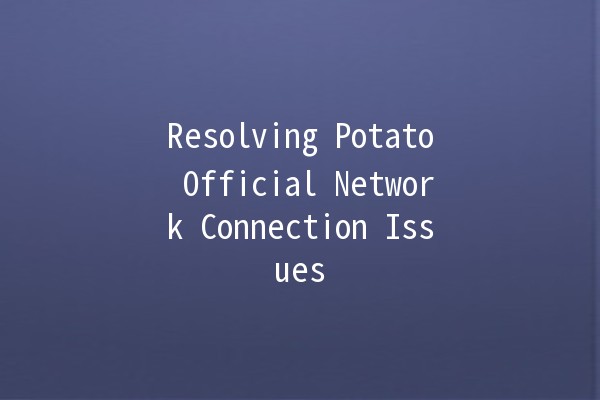In today’s digital landscape, maintaining a stable internet connection is vital, particularly for platforms like Potato that provide users with enriched online experiences. However, users often encounter network connection issues that can be frustrating and disruptive. This article aims to provide practical tips and techniques to enhance productivity while resolving these issues. By following the strategies outlined here, users can optimize their connectivity with Potato and ensure a smoother experience.
Understanding the Root Causes of Network Connection Issues
Before diving into solutions, it’s essential to understand the various factors that can contribute to network connection problems. These include:
Network Congestion: High traffic on your network can slow down your connection.
Router Issues: Faulty or outdated routers may affect connectivity.
ISP Problems: Your Internet Service Provider may face outages or limitations.
Device Compatibility: Compatibility issues with the Potato application can lead to connectivity challenges.
Wrong Settings: Misconfigured network settings can hinder your connection.

Identifying the root cause is crucial for applying the most effective solution.
Productivity Boosting Techniques for Resolving Connection Issues
Description:
Router placement significantly influences your network performance. By optimizing the location of your router, you can enhance signal strength and connectivity.
Practical Application:
Position your router in a central location within your home or office to provide even coverage.
Keep the router elevated and away from physical obstructions such as walls and furniture.
Avoid placing it near electronic devices that can cause interference (e.g., microwaves, cordless phones).
Description:
Updating your router's firmware can resolve security vulnerabilities and performance issues, including connectivity problems.
Practical Application:
Access your router’s settings through your web browser using its IP address.
Look for an option to update the firmware, often found in the administration settings.
Follow the prompts to check for and install the latest firmware version.
Description:
Network congestion occurs when multiple devices connect and utilize bandwidth simultaneously. Reducing the load can improve your connection speed.
Practical Application:
Limit the number of devices connected to your network, especially during hightraffic times.
Schedule large downloads or updates during offpeak hours when fewer users are online.
Use Quality of Service (QoS) settings in your router to prioritize bandwidth for Potato activities over less critical applications.
Description:
Wired connections typically offer more stability and speed than wireless connections, which can be affected by various factors.
Practical Application:
If feasible, connect your computer or device directly to the router using an Ethernet cable.
This eliminates potential wireless interference and ensures a more reliable connection for accessing Potato.
Description:
Resetting your network settings can rectify persistent issues by reverting configurations to their default state.
Practical Application:
On Windows, navigate to Settings > Network & Internet > Status, then select Network reset.
For macOS, go to System Preferences > Network, and then remove and readd your network.
For mobile devices, locate the network settings option in the device settings and perform a reset.
Troubleshooting ContextSpecific Connection Issues
Connectivity with Potato Application
If you’re experiencing issues specifically with the Potato application, consider these contextdriven troubleshooting steps:
Update the Application: Ensure you’re using the latest version of the Potato app to benefit from performance enhancements and bug fixes.
Check Permissions: Ensure the Potato application has the necessary permissions to access your network, especially in mobile devices.
Contact Support: If connection issues persist, reaching out to Potato’s customer support can provide specific insights into ongoing issues and potential resolutions.
Common Questions About Potato's Network Connection Issues
A weak network connection may manifest as slow loading times, frequent disconnections, buffering during video playback, or delayed response times. If you notice these issues, it’s a good indication to diagnose your network setup.
You can test your network speed using tools like Speedtest.net or Fast.com. These services measure both upload and download speeds, giving you a clear understanding of your connectivity capabilities, ensuring they meet the demands for optimal Potato usage.
If your Internet Service Provider is experiencing outages, check their website or contact customer service for updates. In the meantime, consider alternative options such as utilizing mobile data if feasible.
While Potato aims for compatibility across various devices, older hardware or outdated software may experience connectivity woes. Consult Potato's website for compatibility specifications to ensure your device meets the necessary requirements.
A wired connection is generally more stable than WiFi, offering superior speed and reliability. If possible, use Ethernet for the best performance when using Potato to mitigate any connection issues.
Check your router's firmware every few months or specifically when you encounter issues. Manufacturers often release updates to improve security and functionality, which are crucial for maintaining a strong connection.
By implementing the aforementioned techniques and troubleshooting steps, users can significantly enhance their network connectivity with Potato. Optimizing your internet experience is essential in today's fastpaced digital world, and ensuring a reliable connection is the first step toward seamless usage of online platforms. Properly addressing network issues not only boosts productivity but also enriches the overall user experience, allowing you to fully enjoy all the features and functionalities Potato has to offer.